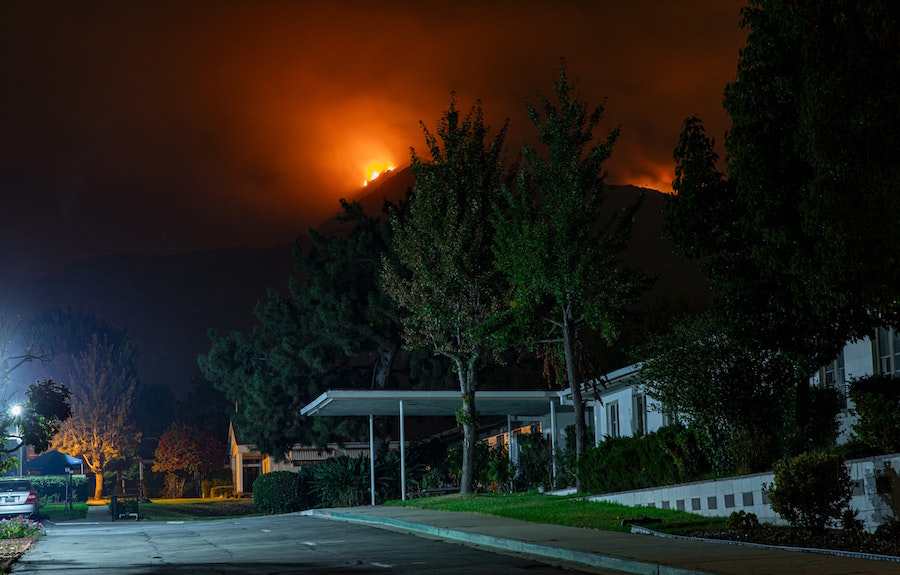We’re in the middle of summer, and at press, there are nearly 300 active wildfires in the province. In the Southern Okanagan Valley, a State of Emergency has been declared and evacuations orders have been issued, displacing hundreds of homeowners in the process. Unfortunately, this news is now commonplace for our province during the season. Climate change is most certainly resulting in drier and hotter summers, which creates optimal conditions for a lightening strike or discarded cigarette to do its dirty work. It’s evident not only in BC, but along the entire west coast.
Homeowners are now wondering if there are more dramatic adjustments that they can make to their physical property to help keep an approaching fire at bay, even if to buy a few extra hours for firefighters to make it on the scene. We have touched on this topic in our updated BC Wildfire Preparedness Guide (please read!) but today we take a look at one concept in particular – landscaping. By investing in landscaping upgrades you can reduce your property’s susceptibility to this growing seasonal threat.
How Landscaping Upgrades Can Reduce Your BC Home’s Vulnerability to Forest Fires
Hardscaping
Traditional landscape design involves softscaping, which encompasses grass, shrubs, gardens and other forms of vegetation. By nature, these create significant vulnerability to wildfire, especially during a drought where watering restrictions are in place. In contrast, hardscaping involves the integration of non-organic materials, and typically includes concrete, asphalt, stone, brick, metal, and gravel – all of which are enemies to an approaching flame. While both concepts are a part of landscape architecture and design, the former (softscaping) is normally much more prominent throughout one’s outdoor space. However, now that climate change has made wildfires a fixture, BC homeowners in at-risk zones may be wise to integrate more hardscaping materials and structures around the circumference of their homes. You don’t need to turn your home into a shopping mall parking lot, but you can certainly tip the balance of landscaping towards non-flammable materials.
Fire-Resistant Fencing
Your fence can be kindle, or a barrier. Choose the latter. Swap out traditional wooden pickets for ignition-resistant lumber (fire retardant treated for exterior exposure), concrete or stone. You can also consider integrating concrete with fire-resistant wood which can actually create a great looking juxtaposition of contrasting materials. After all, we’re not suggesting a prison-esque barricade around your home.
Choose Fire-Resistant Vegetation
No plant life is fireproof. But, certain plants will fan the flames while others are slower burning, providing you with more time to act. Slower burning vegetation have moist and supple leaves, create minimal accumulation of dead vegetation, and have a low amount of sap or resin material. Research fire-resistant plants, shrubs, and trees that you may want to include in your landscape. Remember, fire-resistant does not mean fireproof! Even fire-resistant plants can burn, especially if not well-maintained. Keep all of your plants healthy with adequate pruning, watering, etc.
Remove Flammable Vegetation
Flammable vegetation that you should consider removing from your property include (but are not limited to) the following:
- Cedar
- Juniper
- Pine
- Tall grass
- Spruce
Keep Vegetation Physically-Distanced
We have all heard a lot about social/physical distancing, but even as restrictions lift, this concept should stick when it comes to one thing – vegetation near your home. While you plan on replacing highly-flammable plants with more fire-resistant ones, thoughtful spacing is extremely important. BC FireSmart recommends that vegetation should be kept a minimum of 10-meters away from the exterior and a minimum 1.5 metre non-combustible surface should extend around any attachments, such as decks and patios. This will be a challenge for small outdoor spaces, but ultimately the further away from your home, the better. In addition, keep trees and bushes a minimum 3-meters apart from one another, and prune all branches within 2-meters above the ground unless planted within hardscaping (as per above).
Add Water
Have the kids been bothering you for a swimming pool? It turns out that they may have had the best interests of your home in mind when it comes to wildfire protection. Logically, a swimming pool installation provides an effective barrier against wildfire. That said, there are other aesthetically pleasing water integrations that you can add, including a backyard stream and an array of fountains and bird baths as space and budget allows. The more water, the better. Heck, you can even dig a medieval moat around your home as long as you keep the crocodiles out of the equation (too much potential for personal injury claims).
While these landscaping changes will not ensure that your home will survive a wildfire, they can increase the chances and hopefully give you more time to act. Please review our updated BC Wildfire Preparedness Guide and get in touch with a broker at Park Insurance to ensure that you’re better protected from damage and loss that may come from BC wildfires.

